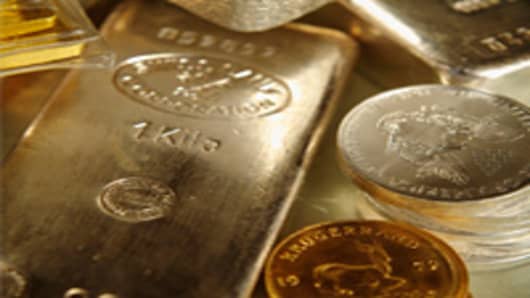With uncertainty clouding the global economic outlook, some wealth advisors are recommending that their high net worth clients hedge against market churn by investing in gold. What's the investment vehicle of choice? Increasingly, it isn't exchange traded funds, futures, or mining stocks — it's the physical gold itself.
In the article on CNBC.com, a UBS executive points to a case where a high net worth client recently bought a ton of gold. Literally. (For those of you scoring at home, that's about 32,150 troy ounces.)
So what does a ton of gold set you back these days? Well, with gold trading at a little over $1,200 an ounce, the back of the envelope math brings your precious metals tab to around $39 million. Not including tax and tip — or transportation by armored car.
But what, exactly, is the lure of gold itself? Sure, gold bugs love the precious metal as a hedge against inflation in uncertain times.
But even when gold was a dreadful investment — between 1980 and 2000, for example — it did little to dampen the spirits of the gold bugs.
It just seems there's something about gold that brings out the inner Bond villain in us all. An asset that can be held in the palm of your hand — and even lovingly caressed — just feels sexier than investing in fixed income derivatives. (Stripping naked and rolling around in a pile of bearer bonds — like Scrooge McDuck on a bad acid trip — isn't nearly as much fun.)
So all this got me wondering: How big is a ton of gold? Where on earth would I put it? Could I stash it in my Manhattan apartment?
Gold is extraordinarily dense — which means you can fit a large amount of weight into a small amount of space. The density of gold is 19.3 grams per cubic centimeter, at room temperature — which means a cube of gold where each face measures one centimeter in length (and width) will weigh a little less than 20 grams while sitting in your rumpus room.
So what does that compare to in the real world? Well, lead — the metal most of us reach for as a metaphor for something really heavy — has a density of 11.34 grams per cubic centimeter. So to put things in perspective, gold is about 70% denser than lead.
Which brings us back to the original question: How big is a ton of gold? First, the metric breakdown: There are a thousand grams in a kilogram and a thousand kilograms in a metric ton, so one metric ton equals one million grams.
Divide the one million grams by a density of 19.32, and you'll get the size of the gold block in cubic centimeters, which comes to about 51,760. Next, calculate the cubic root of 51,760: The answer comes to about 37.26 centimeters — which represents the length of the sides of the cube. Convert that to the English system, and you get about 14 2/3 inches. So the final answer is that a cube of gold that weighs a ton is only a little larger than one foot in all dimensions. About the size of the laser printer sitting on my desk.
But they don't make gold bars that big. The largest pure gold bar ever made was manufactured by Mitsubishi in Japan in 2005. The bar weighed 250 kilograms, or one quarter of a metric ton. (At the time, the gold was valued at $3,684,000 — but, based on current price levels, it's worth close to $10 million today.)
While several standard sizes of gold bars exist, the common trading unit for larger quantities of gold is the kilobar. A kilobar, not surprisingly, weighs one kilogram — or about 2.2 standard pounds.
Based on current prices, a kilobar would cost about thirty-nine thousand dollars. (There are about 12 troy ounces in a kilogram, multiplied by the current price of approximately $1200 per troy ounce.) The dimensions of a gold kilobar are 4 1/2 inches long, by 2 inches wide, by 3/8 of an inch thick — the approximate length and width of a Hershey bar, but three times the thickness.
Postscript: If you've annoyed a coworker with all this trivial knowledge, and he hasn't yet shooed you away, ask him the following question: Which weighs more: An ounce of gold or an ounce of feathers?
Answer: The ounce of gold. Why? Because gold is measured in troy ounces, which are equal to about thirty-one grams; feathers, on the other hand, are measured in the far more common avoirdupois ounces, which equal about twenty-eight grams. ("Avoirdupois" comes from an Old French phrase meaning "goods of weight" — and are the measure we're typically referring to when we talk about ounces and pounds; precious metals, which are measured in troy units, are the notable exception.)
If your colleague still hasn't fallen asleep, point out to him this final paradox: A pound of feathers weighs more than a pound of gold — because there are twelve, as opposed to sixteen, troy ounces in a troy pound.
Then just leave him alone.
Questions? Comments? Email us atNetNet@cnbc.com
Follow NetNet on Twitter @ twitter.com/CNBCnetnet
Facebook us @ www.facebook.com/NetNetCNBC


